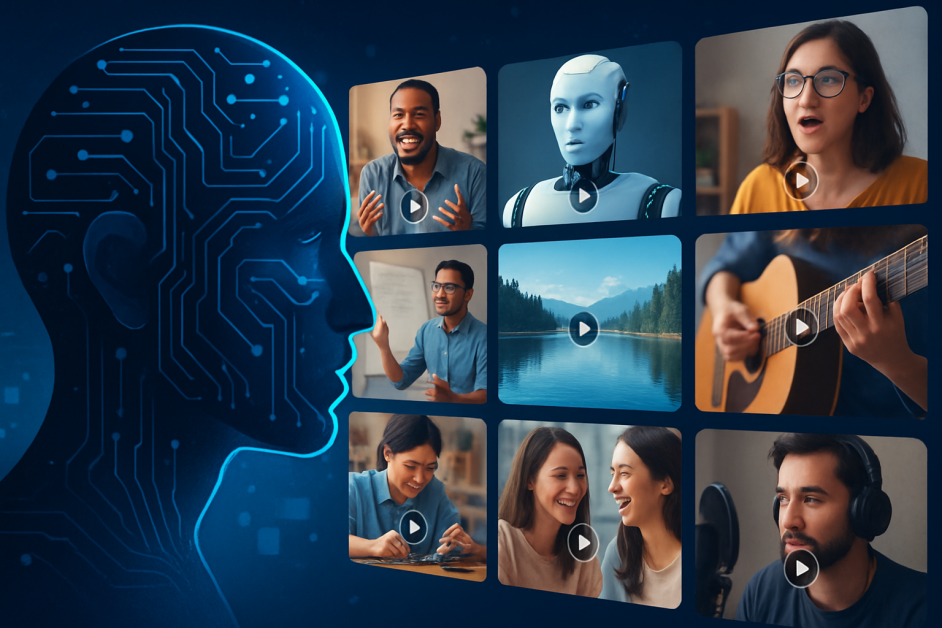人工智能
YouTube 为何可能助力下一代人工智能

YouTube is no longer just a place for watching videos. It has become the largest source of real-world audiovisual data available online. With more than 2.7十亿 active users each month and over 500小时 of video uploaded every minute, YouTube reflects how people live, speak, think, and interact. It captures everyday routines, cultural practices, educational content, and global trends in real-time.
This growing collection of raw, unfiltered, and dynamic content holds great value for DigiOps与人工智能. Most AI models still rely on curated datasets made in controlled settings. However, YouTube offers something more useful, which is real speech, natural language, visuals, sounds, expressions, and text combined in a meaningful context. This multimodal input represents the real world. It allows AI systems to learn how humans behave and communicate in natural situations.
In 2025 and beyond, AI must go beyond static images or short text. It needs to understand emotions, shifting contexts, and signals from different types of content. YouTube is one of the few platforms that offers this kind of variety. It is no longer just a media site, but a living dataset shaped by people around the world.
YouTube can help improve recommendations, train video-language models, and support studies of human behavior. Its size, depth, and changing nature make it worthwhile for future AI systems.
YouTube as the World's Largest Labeled Dataset for AI Training
YouTube's massive video library is not only extensive but also rich in variety. As of 2025, it contains around 5.1十亿 videos, with hundreds of hours added every minute. Each video comes with text-based information like titles, descriptions, comments, and auto-generated subtitles. These details act as soft labels. They help machines understand what the video may be about, even if the content is not manually tagged.
AI systems learn by spotting patterns. YouTube provides a broad mix of content, such as lectures, interviews, tutorials, casual vlogs, music, and more. This variety exposes AI to real language, human reactions, background noise, and cultural differences. It shows how people speak in different tones, accents, and emotional states. Learning from such material helps AI become more adaptable in real situations.
Compared to clean and labeled datasets, YouTube content is messy and unpredictable. People talk over each other, laugh, pause, or switch languages. While this may seem like a problem, it makes AI models stronger. Training on real-world data prepares them to handle noisy audio, crowded scenes, unclear visuals, and mixed signals. This is useful for applications like 语音识别, live translation, assistive tools, and video-based content generation.
Another benefit is the video format itself. Unlike still images or short text, videos show what happens over time. They help AI learn sequences, movements, and cause-and-effect links. This understanding is essential for tasks like action detection, video summarization, or predicting what happens next in a scene.
In simple terms, YouTube teaches machines not just what to see or hear, but how events unfold in life. It gives AI a better sense of time, emotion, and human experience.
From Passive Watching to Active Learning: Why YouTube Is Becoming an AI Playground
YouTube is gradually transforming from a video-sharing platform into a vital training environment for modern AI systems. Its value lies not only in the large volume and wide range of content it hosts, but also in the way it allows AI to learn directly from the real world. Videos uploaded by users around the globe capture unscripted, everyday moments that include human emotions, shifting contexts, and cultural expressions. These elements expose AI models to natural conversations, body language, reactions, and diverse ways of communication at a large scale.
In contrast to traditional datasets that are often clean, labeled, and collected under controlled conditions, YouTube content is noisy and unpredictable. However, this is not a limitation. It mirrors the way humans typically speak and behave, with background noise, interruptions, emotional variation, and spontaneous topic changes. Learning from such complexity helps AI systems become more flexible and better equipped to handle real-life scenarios.
Additionally, YouTube provides useful metadata such as video titles, tags, subtitles, and viewer comments. Although these are not precise labels, they serve as helpful indicators that guide 机器学习 models in interpreting content. When combined with visual and audio signals, this information allows AI to build a multimodal understanding where language, sound, and images are processed together to form a more complete picture.
This approach of training AI using large, dynamic, and weakly labeled video data is a significant step forward. It moves beyond traditional, fixed datasets and brings machines closer to understanding the world in the way humans do. In this sense, YouTube is not just a media library. It acts as a global, real-time learning environment where AI models can observe, learn, and evolve based on authentic human behavior.
How YouTube Trains Smarter Search and Recommendation AI
Every interaction on YouTube generates valuable behavioral data. Actions such as clicking on a video, watching duration, skipping content, or stopping midway provide signals that AI systems can analyze and learn from. These inputs help improve how videos are recommended to each user over time.
The recommendation engine adjusts itself by observing viewer patterns. If a person prefers shorter videos, certain topics, or specific languages, the system notices these trends. It then refines its future suggestions. This type of learning is continuous and does not depend on fixed rules. Instead, it uses past behavior to predict what might interest the viewer next.
YouTube's search function works similarly. It does not rely only on keyword matching. Instead, it uses AI models that try to understand the meaning behind each search. These models consider user intent, language use, and trending topics. As a result, users can often find the right content even when their queries are incomplete or informal.
The development of such systems supports broader applications in other domains. The same methods can be used in e-learning platforms, digital news, health information services, and online shopping. AI systems that learn from user behavior and adapt in real time are becoming important in many fields.
YouTube’s experience shows how search and recommendation engines can evolve. By studying patterns at scale, AI can make content delivery more accurate, timely, and relevant. This model of user-driven learning is becoming a foundation for intelligent digital services across industries.
From Synthetic Media to Conversational AI
AI is now being used not only to understand human behavior but also to generate content that looks and sounds human-like. This has led to the rise of synthetic media, including machine-generated videos, voices, and digital characters. These are created by learning from large amounts of real content, such as YouTube videos, where people speak, move, and express themselves in natural ways.
Tools like Synthesia and Runway allow creators to use AI for tasks such as editing, dubbing, and generating virtual presenters. These applications are helpful in education, advertising, and media production. They help reduce the cost and time needed to produce content and allow people with limited technical skills to create professional-quality media.
However, the growing use of AI in content creation also raises concerns. When machines generate videos or voices, it becomes harder to distinguish between reality and artificiality. This can lead to misinformation or confusion. To address this issue, platforms like YouTube now require that AI-generated content be clearly labeled.
In addition to media generation, AI is improving in understanding human conversation. By learning from extended interviews, casual discussions, and real-time dialogues, AI systems are becoming better at recognizing tone, turn-taking, and topic flow. These improvements help make digital assistants and chatbots more natural and valuable.
Together, these developments show that AI will play a larger role in both creating and delivering content. While the technology offers many benefits, it is essential to ensure that it is used responsibly. Clear labeling, ethical guidelines, and public awareness are necessary to support trust and prevent misuse.
Ethical Challenges in Using YouTube Data for AI
Using YouTube videos to train AI models offers many technical benefits. However, it also raises serious ethical and privacy concerns. Although the content is publicly available, most creators do not expect their videos to be used for machine learning. Their faces, voices, and stories are often personal, and collecting them for AI research without permission raises concerns about consent and respect.
Public access does not mean ethical approval. Using online content for AI training without informing users or asking for their consent can damage trust. In recent years, several AI projects have faced criticism for collecting data without transparency. This has increased public demand for clear explanations about how training data is collected, stored, and used. Platforms and developers are now expected to give users options to opt out of AI training.
To reduce privacy risks, developers can apply technical methods such as data anonymization and differential privacy. These methods help protect individual identities while still supporting AI development. However, privacy safeguards alone are not enough. Even anonymized data must be handled with care to avoid misuse.
Bias is another essential concern. YouTube content is not evenly distributed across regions, cultures, or languages. If AI models are trained mostly on videos from certain groups, they may perform poorly when used elsewhere. This can lead to unfair or misleading results. To reduce such bias, training data must be made more diverse, and models must be tested in different contexts.
Responsible use of YouTube data for AI requires ethical planning. This includes gaining user consent, protecting privacy, improving transparency, and ensuring fairness in training. These steps are essential for building AI systems that are not only powerful but also trustworthy and inclusive.
底线
YouTube is quietly becoming one of the most essential platforms transforming the future of AI. Its massive, diverse, and constantly growing content allows machines to learn in ways that mirror real human behavior. From training more intelligent recommendation engines to enabling synthetic media and conversational AI, YouTube offers both opportunity and complexity.
However, these advances must be balanced with ethical responsibility. As AI learns from public data, it is essential to protect user privacy, ensure transparency, and reduce bias in model training. Without these safeguards, technological progress may come at the cost of public trust. If developed responsibly, AI systems shaped by YouTube’s ecosystem can become more useful, fair, and aligned with real-world needs. The challenge is not just what AI can learn but how we choose to teach it.












